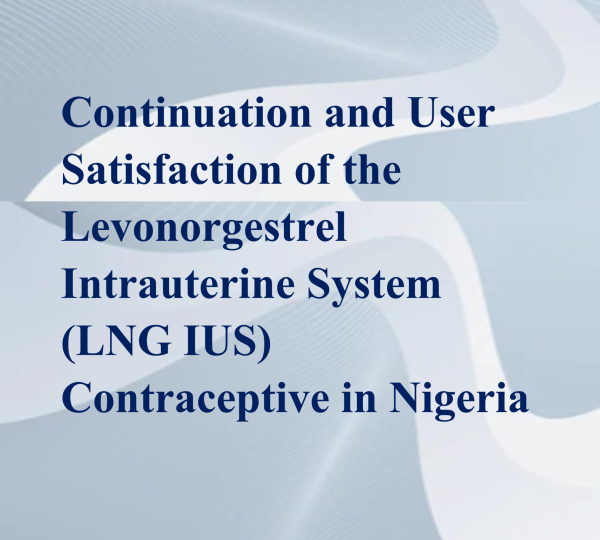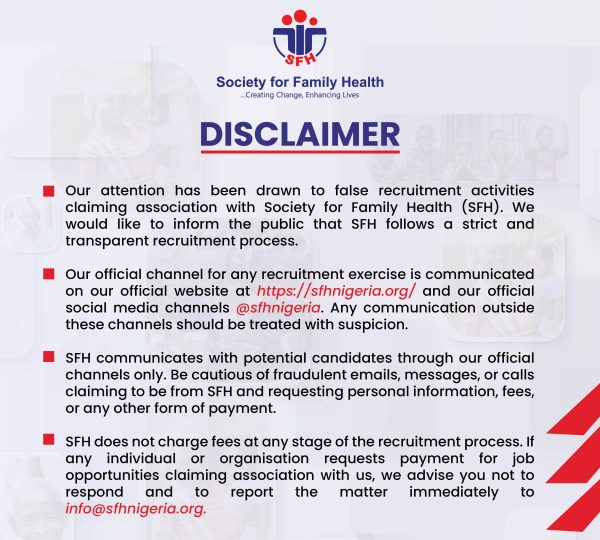AIDS 2022: Looking back to see ahead
By Yusuf Wada Hassan
This past week I joined more than 10,000 people in Montreal, Canada and virtually for the 24th International AIDS Conference (AIDS 2022). As the largest AIDS conference in the world, the gathering brings together a diverse group of people, including political leaders, policy makers, researchers, people living with HIV (PLHIV), advocates, activists and many others committed to ending the epidemic by 2030.
AIDS 2022 served as an opportunity for discussions about recent successes and challenges, scientific advancements and how the global community can continue to work together to fight the disease. Many of these discussions were centred around this year’s theme, “Re-engage and follow the science”, which focused on calling the world to come together to re-engage in defining future research agendas, shift the latest evidence to action and “follow the science” in charting a new consensus on overcoming the HIV pandemic as a public threat. With that in mind, here is a look at some of the key takeaways from the conference:
Dispatches from Montreal
AIDS 2022 took place on un-ceded territory of the Mohawk people and was welcomed by Indigenous Knowledge Keepers at the opening ceremony.
In the days leading up to the conference, the UNAIDS launched a report In Danger, which provides evidenced data on what’s already known on the effect of COVID-19 pandemic on the global HIV response. Progress against HIV did not just stall, but actively lost ground. The HIV Prevention 2025 Road Map by the Global HIV Prevention Coalition released just days later navigates a path to get back on track.
This was also complemented with the recently launched “WHO guidelines for injectable PrEP” and a new voluntary license for ViiV’s pricey bi-monthly injectable Cabotegravir for low income and all Sub-Saharan Countries (90 countries) announced by The ViiV Healthcare and the Medicines Patent Pool. This is a major step to allowing access to affordable versions of the bi-. monthly injectable Cabotegravir and future products, which might help slash new infections.
Successes where also shown and celebrated on the global HIV response, most especially from African countries with Botswana surpassing the UNAIDS 95-95-95 target and Rwanda is well on its way to eliminating Hepatitis C.
Global Village, Advocacy and Protest
AIDS 2022 was a huge success for me with a lot of inspiring advocacy, peaceful protests and village activities beyond “the science” we see at high-level conferences. Its ability to engage the broader community through protest, activism and global village was exemplary (In my mind: “Who tolerates protest in his signature programmes”). This, I think, has and will enable people at the grassroots level, not just experts in the field of HIV and AIDS, to remain really engaged in addressing the global HIV epidemic.
At the opening ceremony, the HIV activist took over the stage to protest the Canadian government’s hostile immigration policies coupled with visa denials, mostly to LMIC delegates, and against the persistent inequality, injustice, stigma, racism, colonisation and underfunding which continues to impede progress and drive new HIV infections. The HIV community activists also stormed the HIV in 2022 and beyond: A view from National Institute of Allergy and Infectious Diseases (NIAID), prime session (featuring Dr. Anthony S Fauci) with powerful speeches about the importance of UequalsU (#U=U), also praising allies Dr. Laura Waters and Dr Anthony S Fauci. His presentation demonstrated the scope and scale of progress made since 1983 focusing on interventions that have emerged over four decades and those now under development.
The Canadian activists also pushed up an activist march to protest and criticize the Canadian government’s high volume of visa denials that kept people from countries most affected by HIV, TB and HCV from attending the conference. Advocates and protesters also demanded political support and full funding to roll out the dapivirine vaginal ring (PrEP Ring), confronted the developer of injectable cabotegravir for PrEP to go further in affordable and transparent pricing, took on an anemic response to monkeypox, and challenged ongoing criminalization of sex workers and other key populations,
The conversations at the global village and exhibition centre were rich, trans-cultural in nature, engaging, inspiring and educational. People held in-depth discussions with scientists, researchers, industry leaders and policymakers. I can only hope that those stakeholders will allow the conversation they had with grassroots people to shape their work in ways that are more people-centered. All in all, there was a lot of science explored ranging from indigenous responses to HIV to surveillance ethics, health innovation, quality healthcare, HIV cure and vaccine research.
Scientific advances
While at the AIDS 2022, A large amount of important research were presented which promises to be game changers in driving progress in these areas, among so many others, and that is why it is so important “follow the science”. The latest research presented was on PrEP and PEP, HIV testing, monkeypox, co-infections and much more. Scientific highlights include:
PEP: Eagerly-awaited results from Doxy PEP were presented with a study showing that a dose of doxycycline after sex can significantly reduce the risk of sexually transmitted infections. This could be the future of STI preventive care but more data needed on AMR (tetracycline resistance).
Monkeypox: Updates on monkey pox prevention, treatment and policy issues, including implications for people living with HIV were presented. There were issue raised from countries like Nigeria on cases non-confirmed due to health system challenges. Rapid and sustained community mobilization and clear guidance to clinicians and patients is critical in their response.
People who inject drugs: New data on the impact of chronic injection opioid use among people living with HIV were presented. Study shows that people who inject drugs are five times at risk of getting infected with HIV. There were consensus on the need to stop criminalization, fund harm reduction and other programmes for people inject drugs. Science should prevail over politics and ideology.
HIV Testing: Compelling new research showed how age-of-consent requirements for HIV testing and HIV criminalization laws are barriers to HIV prevention and care. Rising HIV diagnoses and low rates of testing is driving by much higher rate of punitive laws. Study shows that age of consent requirements impact prevalence of HIV testing among adolescents – less testing with more conservative age restrictions. It is also now possible to undergo HIV testing without prescription and with 100% cost covered under universal health coverage in countries such as France.
Comorbidities New studies on HIV and co-infections, including tuberculosis and hepatitis, as well as research on hepatitis C reinfection. CRP for TB screening was presented in outpatient PLHIV as a quick and easy test (available as POC in some settings) could be used as a proxy TB screening tool, minimizing excessive sputa testing in resource limited but high TB and HIV countries. AIDS response must include advocacy to End TB!
Mental Health: There were presentation on the latest science on PTSD risk and mental health service utilization among people living with HIV.
HIV Cure: The City of Hope patient has remained free of HIV since ending HIV treatment 17 months ago. He is now the fifth known case of an HIV cure after receiving a stem cell transplant. Also at the IAS pre-conference which features HIV Cure workshop, there were useful discussion on the progress and advances in finding a cure for HIV.
Women and girls
Women and girls overwhelmingly bear the burden of HIV infection rates. According to the “In danger” UNAIDS 2022 Global updates, HIV prevalence among women, and girls was at an increased risk. In every two minutes in 2021, an adolescent girl or young woman was newly infected with HIV and 63% of all new HIV infections were accounted by women and girls in sub-Saharan Africa. Further, every week, 4200 girls and women aged 15-24 in Sub-Saharan Africa acquire HIV. Each one of these infections could be prevented if young people had the right information and services.
Children
Globally, only half (52%) of children living with HIV are on life-saving treatment according to the new UNAIDS reports. This is far behind adults where three quarter (76%) are receiving antiretroviral. This brought together UNAIDS, UNICEF and WHO to fix one of the most glaring disparities in the AIDS response with the launch of the “New global alliance to end AIDS in children by 2030”. In addition to these agencies, other twelve countries including Nigeria have joined the alliance with other civil society movement’s organizations and international partners such as PEPFAR and Global Fund at the first phase for the next eight years.
A focus on Youth
The exhibition, symposium, and features included youth focus activities either for the youth or led by the youths. At the global village, young people presented activities on different social accountability tools used by young people and key affected populations in Uganda and Kenya to improve service delivery. Other youth activities at the global village features session showcased various engagement models aiming for young people to have a voice in paediatric research and trials and on the integration of the “Doing Development Differently (DDD)” agenda in programmes targeting young people living with and affected by HIV/AIDS. There was also the launch of a digital Youth Hub
Financing the fight
So, for all the excitement about science, these advances still only reach a minority of people who need them. Inequalities are driving almost all pandemics. Making drugs affordable and globally available far faster is key through strategic financing that removes barriers across countries and within. There were calls on the world leaders to step up pledges and new commitments to the Global Fund replenishments. This is even more important with the substantial reduction in resources available for HIV in LMIC, leaving their HIV response $8 billion short of the amount needed by 2025.
While advances in HIV science and service delivery and implementation must be pursued with exuberance, now is the time to urgently scale up quality, affordable and accessible service for everyone and put community voices to be centered in the fight to end AIDS. We also need to address political and structural obstacles, financing and limited implementation at scale. This are the main messages that resonate all throughout the 24th International AIDS Conference.
Yusuf Hassan Wada is an Executive Assistant at the Society for Family Health and served as a Rapporteur for AIDS 2022. This content is solely his opinion and doesn’t reflect the organization or position he serves.



